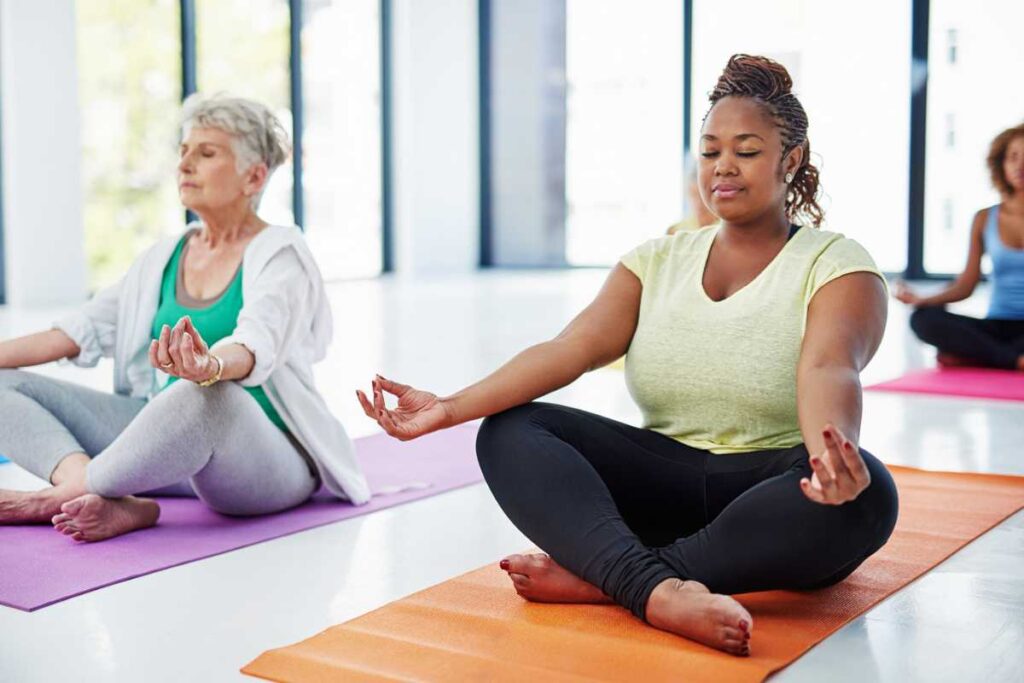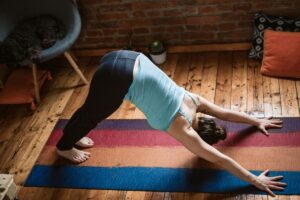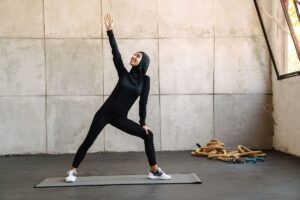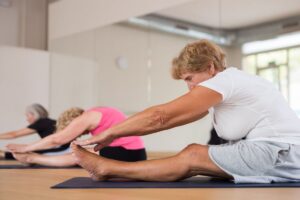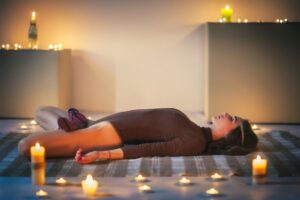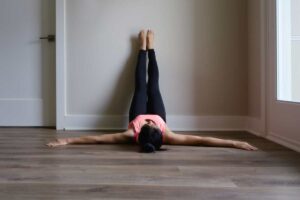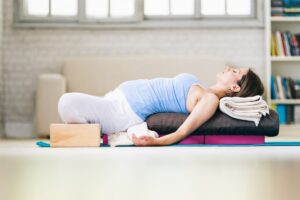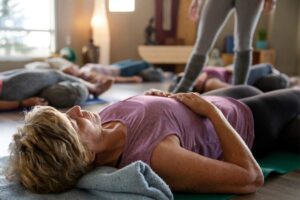Whether you are a beginner or an experienced practitioner, various types of yoga can specifically help with activities of daily living and some of the symptoms commonly experienced during the menopause journey. But what type of yoga is best for you? Learn about the types of yoga and how the practice can enhance your emotional and physical well-being, help you manage chronic conditions, and improve overall quality of life during the menopause journey.
What is yoga?
Yoga is a discipline that aims to unite the mind, body, and spirit. The practice has been around for centuries, originating in ancient India. It’s a holistic approach to physical and mental well-being. It goes beyond physical exercise and focuses on achieving balance and harmony in all aspects of life.
The word “yoga” comes from the Sanskrit word “yuj,” which means to join or unite.
Yoga incorporates various techniques and practices, including physical body postures, breathing, meditation, and relaxation.
These practices work together to improve:
- flexibility
- strength
- balance
- mental clarity
During the menopause journey, yoga can help:
- ease stress
- improve your mindset
- help you manage physical symptoms like hot flashes and sleeplessness
If you need a guide to foundational yoga poses and how to do them, start here.
5 types of yoga and their benefits
Several types of yoga can help with your day-to-day activities and menopause symptoms.
When choosing a fitness studio or online class to try at home, you may see these yoga types offered. Learn about each type and the benefits it can offer.
In addition, yoga enhances stretching.
Ashtanga yoga
Ashtanga yoga is a dynamic and physically demanding practice that follows a specific sequence of postures. It focuses on synchronizing breath with movement and building strength, flexibility, and stamina.
This type of yoga can be particularly beneficial for daily activities that require endurance and physical exertion, such as carrying groceries, climbing stairs, or performing household chores.
By practicing Ashtanga yoga regularly, you can improve your overall fitness levels and enhance your ability to engage in these activities with ease.
Vinyasa flow yoga
Vinyasa flow yoga allows for more creativity and freedom than Ashtanga, which is a structured and disciplined approach.
Vinyasa is a dynamic and fluid practice emphasizing the continuous flow of movement from one pose to another. It combines breath and movement in a seamless sequence, promoting strength, flexibility, and balance.
Vinyasa flow yoga can be beneficial for daily activities that require coordination and agility, such as walking, bending, and reaching.
You can practice the same five moves as Ashtanga yoga in Vinyasa flow, with a focus on creativity and freedom in Vinyasa.
Practicing Vinyasa flow yoga can enhance your body awareness and improve your ability to move gracefully and efficiently in your everyday life.
Ashtanga vs. Vinyasa yoga poses
Try these 5 Ashtanga and Vinyasa yoga poses:
- Downward facing dog
- Warrior II
- Headstand
- Seated forward bend
- Corpse pose
Depending on the type of yoga you’re doing, your pose will be more creative or structured.
1. Downward facing dog
Downward Facing Dog, or Adho Mukha Svanasana, is a foundational pose in both Ashtanga and Vinyasa yoga.
In Ashtanga, it is typically held for five breaths as part of the Sun Salutation sequence.
In Vinyasa, it is often used as a transitional pose, flowing smoothly between other poses.
The main difference lies in the emphasis on alignment and precision in Ashtanga, whereas Vinyasa allows for more fluidity and creativity.
2. Warrior II
Warrior II, or Virabhadrasana II, is a powerful standing pose that builds strength and stability. In Ashtanga, it is held for a longer duration as part of the standing sequence.
In Vinyasa, it may be incorporated into a flow, transitioning between poses dynamically.
Ashtanga focuses on holding the pose with precision, while Vinyasa encourages smooth transitions and creative variations.
3. Headstand
Headstand, or Sirsasana, is an advanced inversion pose that offers numerous benefits for the body and mind.
In Ashtanga, it is typically practiced towards the end of the primary series after building strength and stability in the preceding poses.
In Vinyasa, it may be incorporated as part of an inversion flow, allowing for more exploration and variations. Ashtanga emphasizes a structured and progressive approach, while Vinyasa offers more flexibility and adaptability.
4. Seated forward bend
Seated forward bend, or Paschimottanasana, is a calming pose that stretches the entire back of the body.
In Ashtanga, it is often practiced towards the end of the seated sequence, focusing on deepening the stretch and maintaining the alignment.
In Vinyasa, it may be incorporated into a flow, allowing for more dynamic movement and variations.
Ashtanga emphasizes holding the pose with precision, while Vinyasa encourages a more fluid and creative approach.
5. Savasana or corpse pose
Savasana, or corpse pose, is the final relaxation pose in yoga practice. It allows the body and mind to integrate the benefits of the practice.
In both Ashtanga and Vinyasa, Savasana is essential and typically practiced at the end of the session. The main difference lies in the duration and approach.
Ashtanga often has a shorter Savasana, while Vinyasa allows for a longer and more meditative experience.
Differences between Vinyasa and Ashtanga
| Pose | Vinyasa | Ashtanga |
|---|---|---|
| Downward facing dog | Allows for creativity and fluidity. | Focus on precision and alignment. |
| Warrior II | Encourages smooth transitions and creative variations. | Hold the pose with precision. |
| Headstand | Offers flexibility and adaptability. | Take a structured and progressive approach. |
| Seated forward bend | Have a fluid and creative approach. | Hold the pose with precision. |
| Corpse pose | The experience can be longer and more meditative. | Shorter Savasana. |
Both styles have their unique benefits and appeal. Ultimately, the choice between the two styles depends on personal preference and individual goals.
Both provide an opportunity for growth, self-discovery, and overall well-being. Exploring different yoga styles and poses can enhance your practice and help you find the style that resonates with you the most.
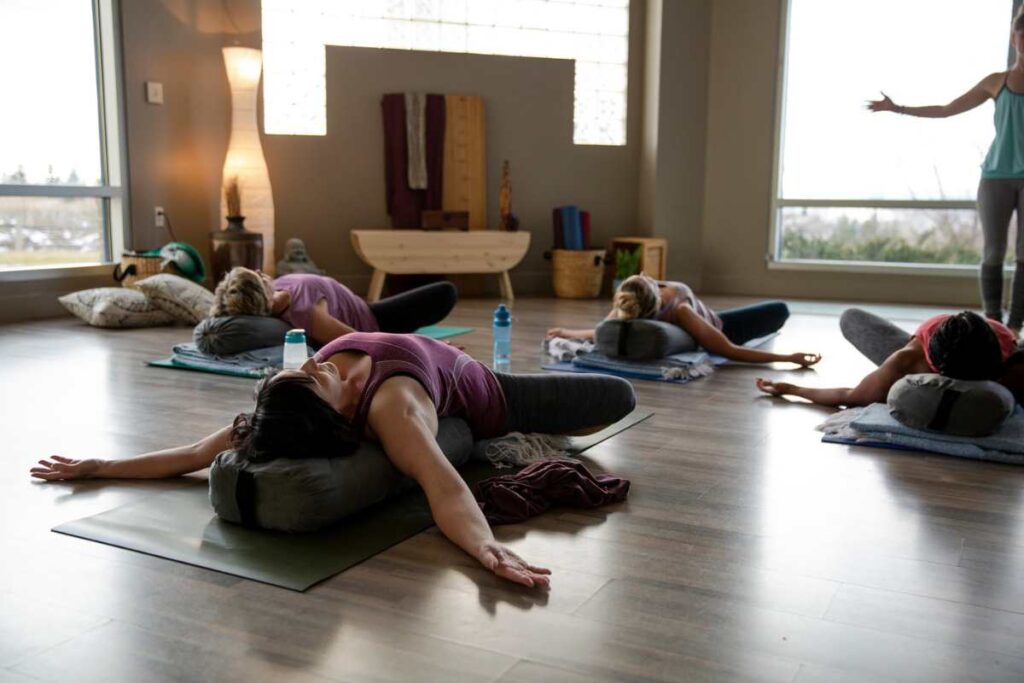
Restorative Yoga
Restorative Yoga is a gentle and relaxing practice that focuses on deep relaxation and rejuvenation. It involves holding supported poses for an extended period, allowing the body and mind to unwind and release tension.
It can also help with activities of daily living that require rest and recovery, sitting for long periods, or managing stress.
This type of yoga can be particularly beneficial for women+ on the menopause journey, as it helps to reduce stress and anxiety, improve sleep quality, and balance hormonal fluctuations.
Incorporating restorative yoga into your routine can reduce fatigue and enhance your overall well-being.
Pose examples for restorative yoga
Here are 5 restorative yoga poses that can be beneficial for the menopausal transition and for mindfulness.
- Supported child’s pose
- Legs-up-the-wall pose
- Reclining bound angle pose
- Supported bridge pose
- Supported corpse pose
1. Supported child’s pose (Balasana)
This pose gently stretches the hips, thighs, and lower back while promoting a sense of surrender and relaxation.
2. Legs-up-the-wall pose (Viparita Karani)
Lie on your back with your legs extended up against a wall. This pose helps to relieve fatigue, reduce swelling in the legs, and calm the nervous system.
3. Reclining bound angle pose (Supta Baddha Konasana)
This pose opens the hips and groin, while also promoting relaxation and reducing anxiety.
4. Supported bridge pose (Setu Bandha Sarvangasana)
Lie on your back with a bolster or folded blanket under your hips. This pose helps to relieve lower back pain and fatigue, while also promoting deep relaxation.
5. Supported corpse pose (Savasana)
Lie on your back with a bolster or folded blanket under your knees. This pose promotes deep relaxation, reduces stress, and helps to improve sleep quality.
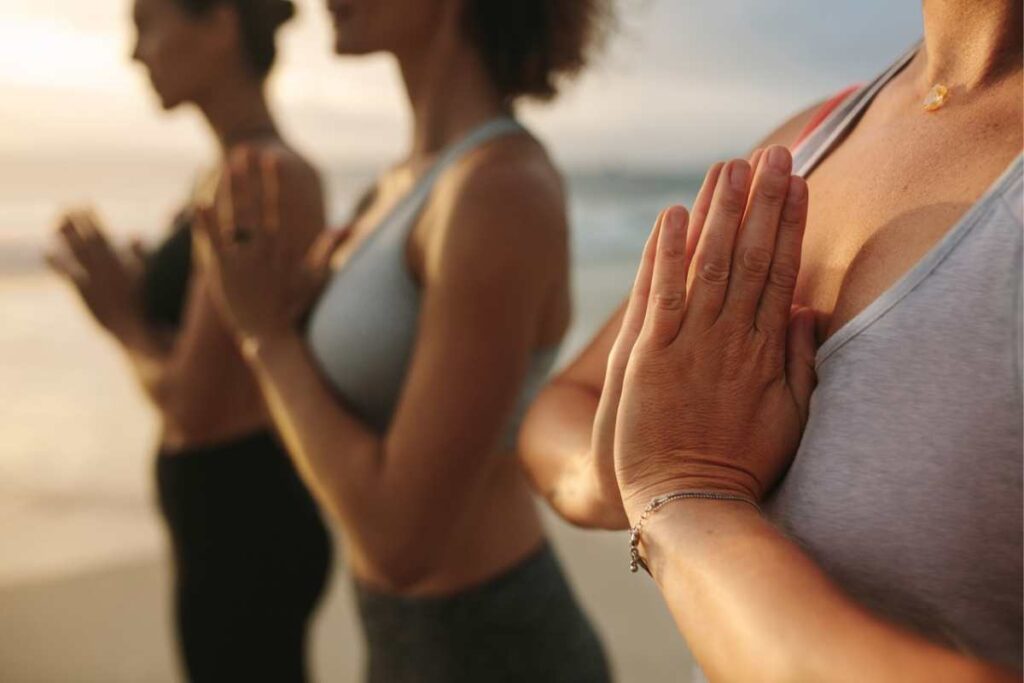
Mindfulness
Mindfulness is a key aspect of yoga that can greatly enhance your daily activities and your menopause journey.
By practicing mindfulness, we cultivate a greater sense of presence and awareness in our daily experiences. This allows us to fully engage in each moment, whether it’s eating, walking, or interacting with others.
Mindfulness can help us to slow down, reduce stress, and make more conscious choices in our daily lives.
By incorporating mindfulness techniques, such as mindful eating or mindful breathing, into our daily activities, we can bring a greater sense of calm and clarity to our daily experiences.
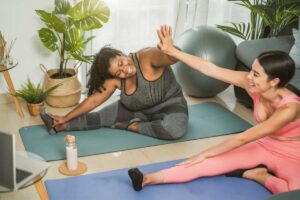 Stretching
Stretching
In addition to specific types of yoga, incorporating any form of stretching into your daily routine can greatly benefit your daily living activities.
Stretching helps to improve flexibility, maintain joint mobility, and prevent muscle imbalances. It can be especially helpful for activities that involve bending, lifting, or reaching, as it prepares your body for these movements and reduces the risk of injury.
Consider incorporating gentle stretches for different muscle groups, such as the neck, shoulders, back, hips, and legs, into your daily routine to enhance overall mobility and ease of movement.
Deep Breathing
Deep breathing is an essential component of yoga that can have a profound impact on our activities of daily living. By practicing deep breathing techniques, such as diaphragmatic breathing or alternate nostril breathing, we can activate the relaxation response in our body, reducing stress and promoting a sense of calm.
Deep breathing can be particularly beneficial for activities requiring focus, concentration, or challenging situations.
By incorporating deep breathing into our daily routine, we can enhance our ability to stay calm and centered, even during daily pressures and demands.
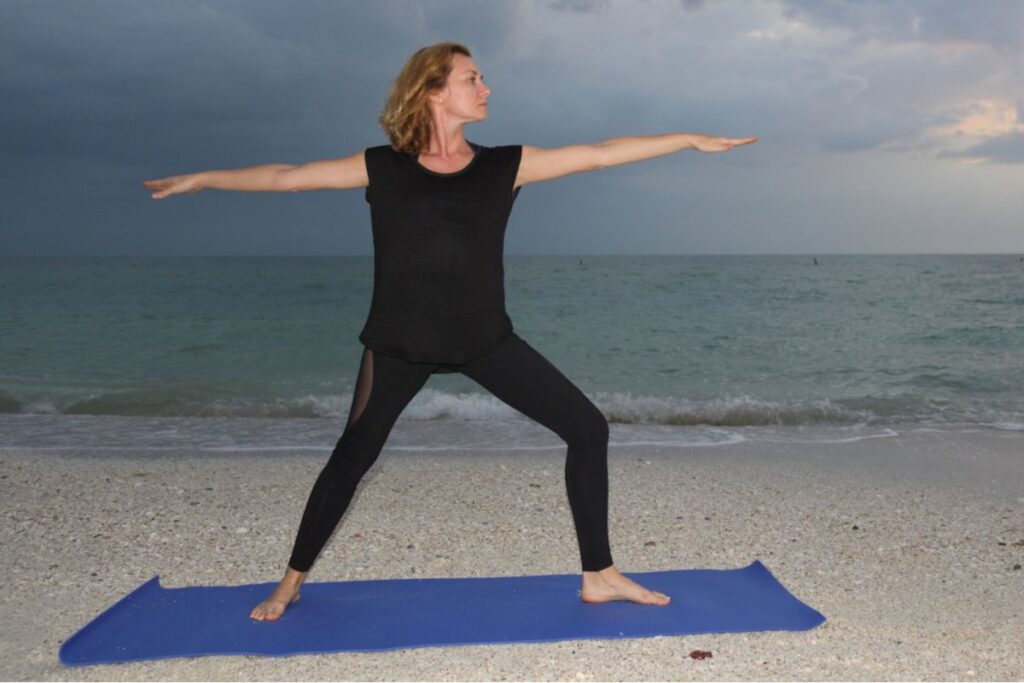
Yoga for lifelong strength
A yoga practice can greatly enhance your strength as you age, so you can move through daily life with greater ease and comfort.
Yoga offers a wide range of tools to support overall well-being and menopause symptoms – whether it’s practicing Ashtanga or Vinyasa Flow Yoga to improve strength and flexibility, engaging in Restorative Yoga for relaxation and rejuvenation, incorporating stretching for improved mobility, or cultivating mindfulness and deep breathing for greater presence and calm.
Remember, it is important to listen to your body and only do what feels comfortable. If you have any specific concerns or medical conditions, it is always best to consult with a qualified yoga instructor or healthcare professional before starting any new exercise routine.
Yoga can help ease your mind and stress. If you’d like more tips to manage stress, download the Be Less Stressed Toolkit.
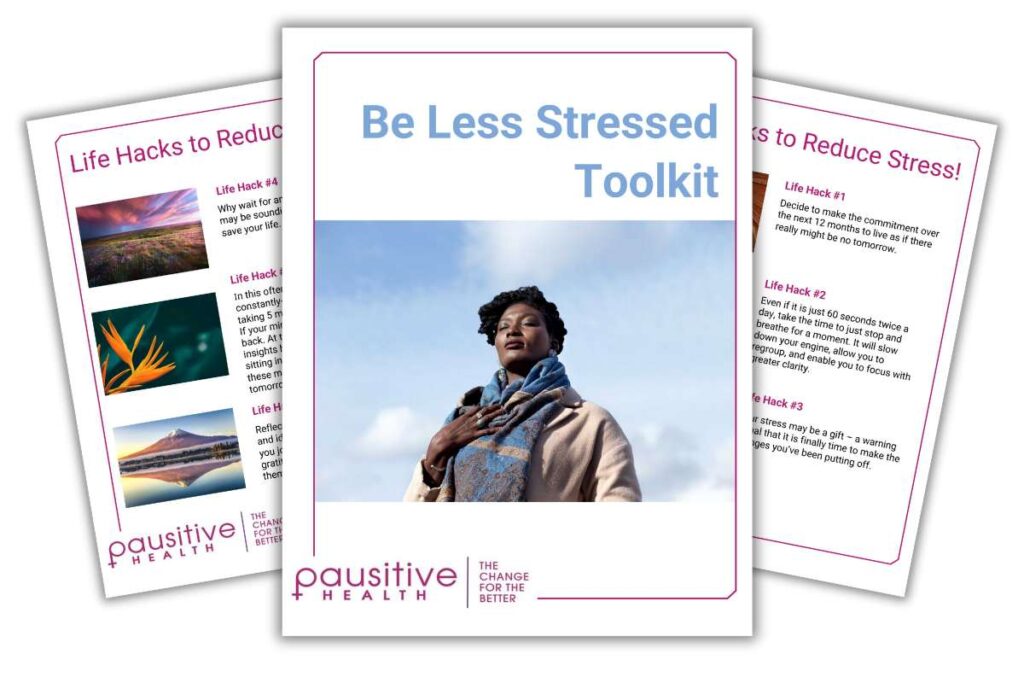
Be Less Stressed
Feeling stressed or overwhelmed? Learn life hacks to reduce stress with the Be Less Stressed toolkit.
"*" indicates required fields
By exploring and incorporating these different types of yoga into your routine, you can enhance your ability to engage in daily activities with greater grace and mindfulness.

Fatima Karim-Murji
Fatima is a Canadian-trained Registered Nurse of 26 years, with a Bachelor of Science in Nursing and a Master of Science specializing in Health Sciences. Her clinical background in medical surgical nursing, maternity, neurology, population health management, healthcare benefits and management, along with engagement strategies for corporations, has taught her a lot about wellness and sustaining a healthy lifestyle. She is certified with the Wellness Council of America (WELCOA) and has extensive training in Mental Health First Aid for Adults and Youth. She is a Registered Yoga Teacher and Mindfulness Guide (RYT 200hrs).
For the past five years, she’s focused her energy on yoga and mindfulness, teaching students in person 1-on-1, virtually during COVID-19, at corporate wellness events, and in the studio. Her passion is working with people from all walks of life to maintain a healthy work- life balance through their health journey. Whether it be in an office environment, at your desk, in a classroom, at the studio, or virtually, yoga and mindfulness can be done anywhere, anytime. Fatima lives in Dallas, Texas where she enjoys teaching and practicing Yoga, spending time with family and friends, and seeing all that the world has to offer. Sign up for our monthly newsletter and get updates on what’s new at AsanawithFatima.com.
You may also like…
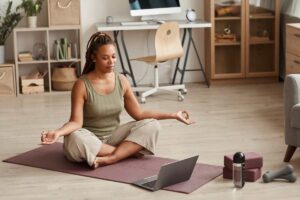
Discover Inner Balance: 8 Yoga Poses To Help Manage Menopause Symptoms
Yoga can improve your emotional and physical well-being during menopause, easing symptoms like hot flashes and sleeplessness. Try these yoga poses. for menopause.

28 At-Home Osteoporosis Exercise Videos To Help Prevent or Manage It
Try these at-home osteoporosis exercise videos from our collaborative partner. They can help prevent or manage osteoporosis and osteopenia.
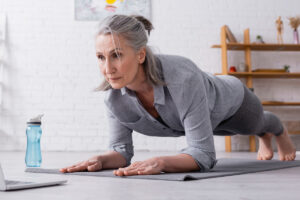
Menopause Exercise Videos To Improve How You Feel
Try these menopause exercise videos to improve how you feel. They can help with weight loss, body strength, and flexibility.

